MKT01760 Tourism Planning: Addressing Beach Degradation
VerifiedAdded on 2023/06/04
|23
|4461
|245
Report
AI Summary
This report examines the environmental challenges facing the Gold Coast beaches in Australia due to tourism, including pollution and sea water rise, which impact the region's tourism development. It identifies factors contributing to the issue, such as urbanization, industrialization, and over-tourism, leading to beach erosion and environmental degradation. The report then proposes a tourism development plan focused on sustainable practices, waste management, and environmental protection, involving government and environmental agencies. The plan aims to balance the needs of tourists and businesses with the preservation of environmental resources, ensuring long-term sustainability of tourism on the Gold Coast. Desklib provides access to similar solved assignments for students.

Running Head: TOURISM THEORIES AND PRACTICES
TOURISM THEORIES AND PRACTICES
Name of the Student:
Name of University:
Author Note:
TOURISM THEORIES AND PRACTICES
Name of the Student:
Name of University:
Author Note:
Paraphrase This Document
Need a fresh take? Get an instant paraphrase of this document with our AI Paraphraser
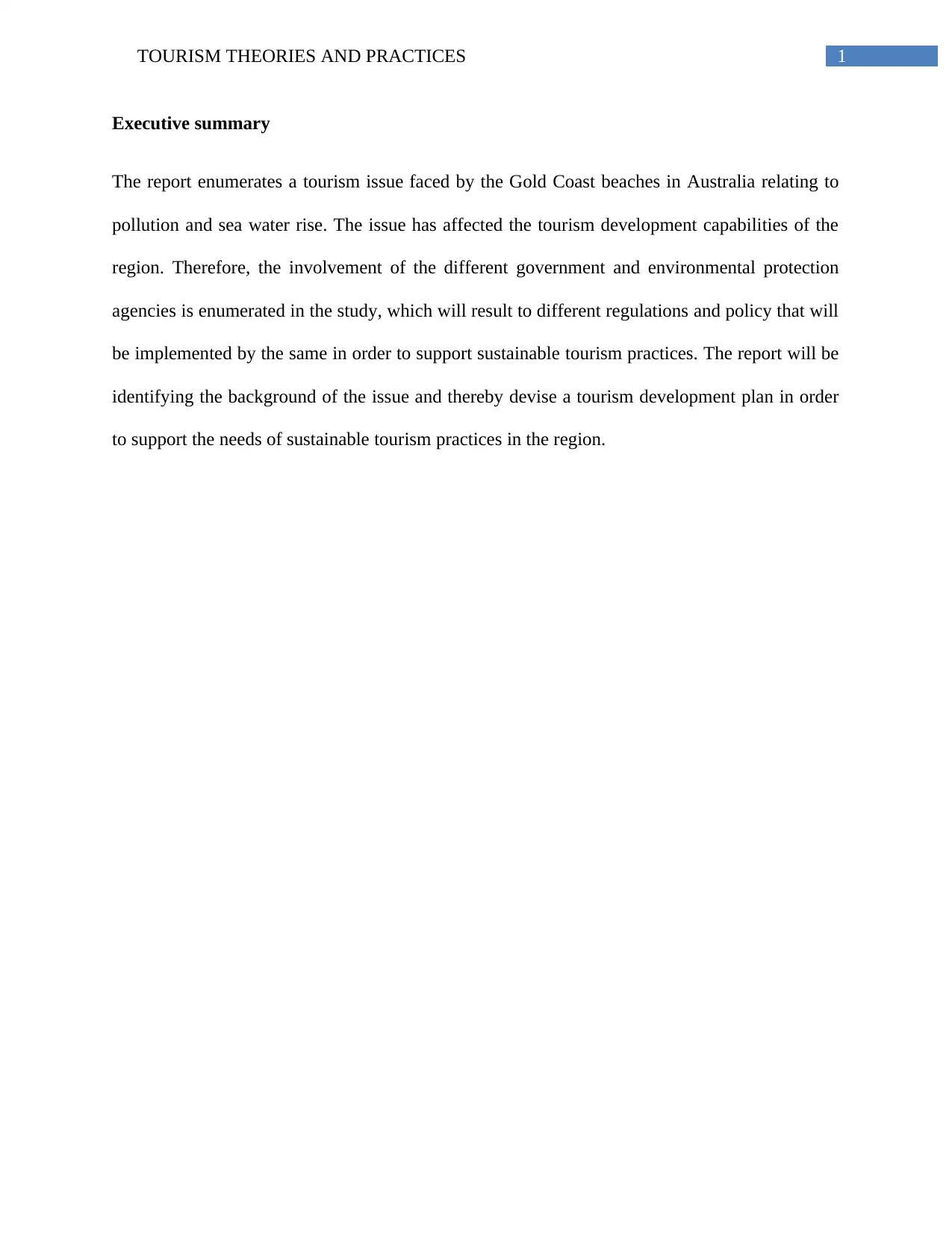
1TOURISM THEORIES AND PRACTICES
Executive summary
The report enumerates a tourism issue faced by the Gold Coast beaches in Australia relating to
pollution and sea water rise. The issue has affected the tourism development capabilities of the
region. Therefore, the involvement of the different government and environmental protection
agencies is enumerated in the study, which will result to different regulations and policy that will
be implemented by the same in order to support sustainable tourism practices. The report will be
identifying the background of the issue and thereby devise a tourism development plan in order
to support the needs of sustainable tourism practices in the region.
Executive summary
The report enumerates a tourism issue faced by the Gold Coast beaches in Australia relating to
pollution and sea water rise. The issue has affected the tourism development capabilities of the
region. Therefore, the involvement of the different government and environmental protection
agencies is enumerated in the study, which will result to different regulations and policy that will
be implemented by the same in order to support sustainable tourism practices. The report will be
identifying the background of the issue and thereby devise a tourism development plan in order
to support the needs of sustainable tourism practices in the region.
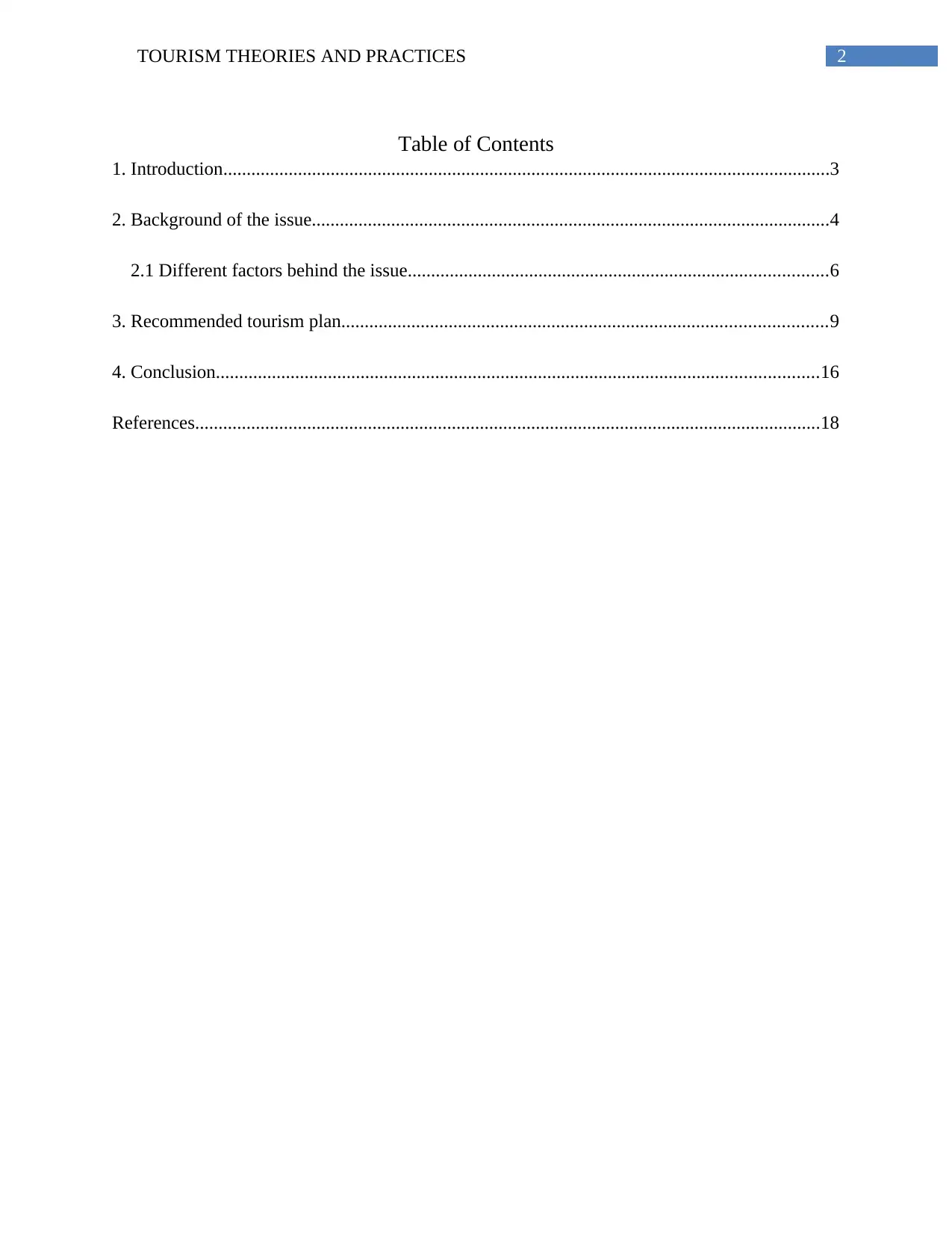
2TOURISM THEORIES AND PRACTICES
Table of Contents
1. Introduction..................................................................................................................................3
2. Background of the issue...............................................................................................................4
2.1 Different factors behind the issue..........................................................................................6
3. Recommended tourism plan........................................................................................................9
4. Conclusion.................................................................................................................................16
References......................................................................................................................................18
Table of Contents
1. Introduction..................................................................................................................................3
2. Background of the issue...............................................................................................................4
2.1 Different factors behind the issue..........................................................................................6
3. Recommended tourism plan........................................................................................................9
4. Conclusion.................................................................................................................................16
References......................................................................................................................................18
⊘ This is a preview!⊘
Do you want full access?
Subscribe today to unlock all pages.

Trusted by 1+ million students worldwide
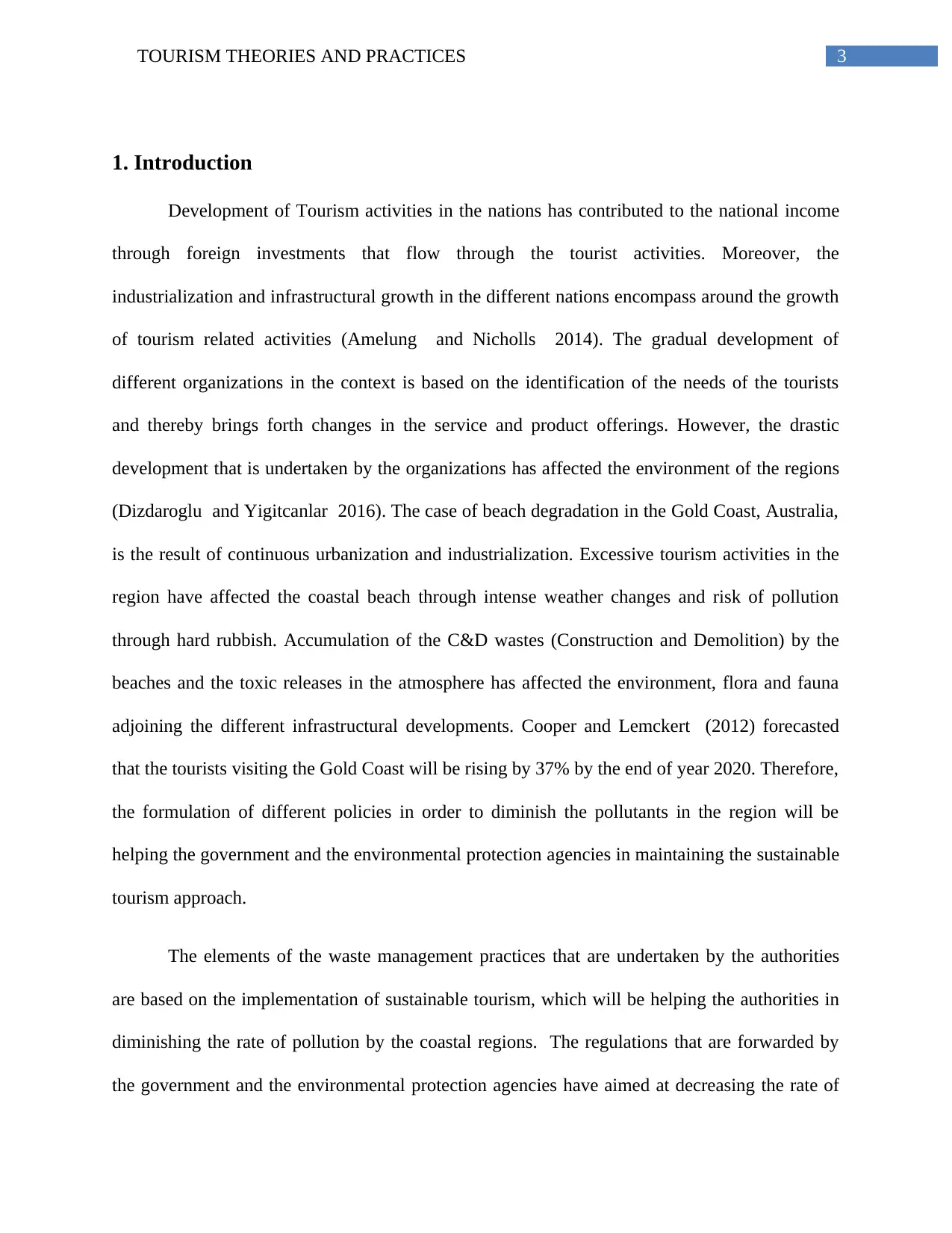
3TOURISM THEORIES AND PRACTICES
1. Introduction
Development of Tourism activities in the nations has contributed to the national income
through foreign investments that flow through the tourist activities. Moreover, the
industrialization and infrastructural growth in the different nations encompass around the growth
of tourism related activities (Amelung and Nicholls 2014). The gradual development of
different organizations in the context is based on the identification of the needs of the tourists
and thereby brings forth changes in the service and product offerings. However, the drastic
development that is undertaken by the organizations has affected the environment of the regions
(Dizdaroglu and Yigitcanlar 2016). The case of beach degradation in the Gold Coast, Australia,
is the result of continuous urbanization and industrialization. Excessive tourism activities in the
region have affected the coastal beach through intense weather changes and risk of pollution
through hard rubbish. Accumulation of the C&D wastes (Construction and Demolition) by the
beaches and the toxic releases in the atmosphere has affected the environment, flora and fauna
adjoining the different infrastructural developments. Cooper and Lemckert (2012) forecasted
that the tourists visiting the Gold Coast will be rising by 37% by the end of year 2020. Therefore,
the formulation of different policies in order to diminish the pollutants in the region will be
helping the government and the environmental protection agencies in maintaining the sustainable
tourism approach.
The elements of the waste management practices that are undertaken by the authorities
are based on the implementation of sustainable tourism, which will be helping the authorities in
diminishing the rate of pollution by the coastal regions. The regulations that are forwarded by
the government and the environmental protection agencies have aimed at decreasing the rate of
1. Introduction
Development of Tourism activities in the nations has contributed to the national income
through foreign investments that flow through the tourist activities. Moreover, the
industrialization and infrastructural growth in the different nations encompass around the growth
of tourism related activities (Amelung and Nicholls 2014). The gradual development of
different organizations in the context is based on the identification of the needs of the tourists
and thereby brings forth changes in the service and product offerings. However, the drastic
development that is undertaken by the organizations has affected the environment of the regions
(Dizdaroglu and Yigitcanlar 2016). The case of beach degradation in the Gold Coast, Australia,
is the result of continuous urbanization and industrialization. Excessive tourism activities in the
region have affected the coastal beach through intense weather changes and risk of pollution
through hard rubbish. Accumulation of the C&D wastes (Construction and Demolition) by the
beaches and the toxic releases in the atmosphere has affected the environment, flora and fauna
adjoining the different infrastructural developments. Cooper and Lemckert (2012) forecasted
that the tourists visiting the Gold Coast will be rising by 37% by the end of year 2020. Therefore,
the formulation of different policies in order to diminish the pollutants in the region will be
helping the government and the environmental protection agencies in maintaining the sustainable
tourism approach.
The elements of the waste management practices that are undertaken by the authorities
are based on the implementation of sustainable tourism, which will be helping the authorities in
diminishing the rate of pollution by the coastal regions. The regulations that are forwarded by
the government and the environmental protection agencies have aimed at decreasing the rate of
Paraphrase This Document
Need a fresh take? Get an instant paraphrase of this document with our AI Paraphraser

4TOURISM THEORIES AND PRACTICES
pollution that is created through the infrastructural growth by the Gold Coast. The environment
protection agencies has undertaken Beach nourishment, beach cleaning, dune restoration and
restrictions on different tourism activities in order to protect the beaches from being eroded.
However, the growth of the businesses relating to the diverse preferences of the tourists has
affected the sustainable approach that is formulated by the protection agencies.
The purpose of the research is to study the background of the issue in detail and thereby
identify the factors that influence the issue. On the other hand, the report also enumerate4s
different recommended actions that might be taken by the environmental protection agencies in
order to promote sustainable tourism practices in the region for uplifting the needs of the tourists
and the development of different businesses. The tourism plan will be helping to exemplify the
different practices through which tourism activities might be supported in order to ensure the
sustainable tourism activities that will be having a keen objective of protecting the environmental
resources without negating the needs of the growth of tourism activities in the region.
2. Background of the issue
According to Phillips et al. (2015) there are a number of vulnerability factors that impact
heavily on the coastal environments. The climate change, population growth and the economic
boom are the intrinsic parts of those vulnerability factors. As a result of that there is a huge
pressure vested on the coastal environment. In this regard, the coastal environment of Gold
Coast, Australia has become the primary part of this discussion. It can be argued that the Gold
Coast city of Australia has grown substantially with the help of its ever increasing tourism
industry (Sedigh et al. 2015). As a matter of fact, this escalating trend in the tourism industry
facilitates an urban characteristics to the Gold Coast city. The Gold Coast beaches are very
pollution that is created through the infrastructural growth by the Gold Coast. The environment
protection agencies has undertaken Beach nourishment, beach cleaning, dune restoration and
restrictions on different tourism activities in order to protect the beaches from being eroded.
However, the growth of the businesses relating to the diverse preferences of the tourists has
affected the sustainable approach that is formulated by the protection agencies.
The purpose of the research is to study the background of the issue in detail and thereby
identify the factors that influence the issue. On the other hand, the report also enumerate4s
different recommended actions that might be taken by the environmental protection agencies in
order to promote sustainable tourism practices in the region for uplifting the needs of the tourists
and the development of different businesses. The tourism plan will be helping to exemplify the
different practices through which tourism activities might be supported in order to ensure the
sustainable tourism activities that will be having a keen objective of protecting the environmental
resources without negating the needs of the growth of tourism activities in the region.
2. Background of the issue
According to Phillips et al. (2015) there are a number of vulnerability factors that impact
heavily on the coastal environments. The climate change, population growth and the economic
boom are the intrinsic parts of those vulnerability factors. As a result of that there is a huge
pressure vested on the coastal environment. In this regard, the coastal environment of Gold
Coast, Australia has become the primary part of this discussion. It can be argued that the Gold
Coast city of Australia has grown substantially with the help of its ever increasing tourism
industry (Sedigh et al. 2015). As a matter of fact, this escalating trend in the tourism industry
facilitates an urban characteristics to the Gold Coast city. The Gold Coast beaches are very
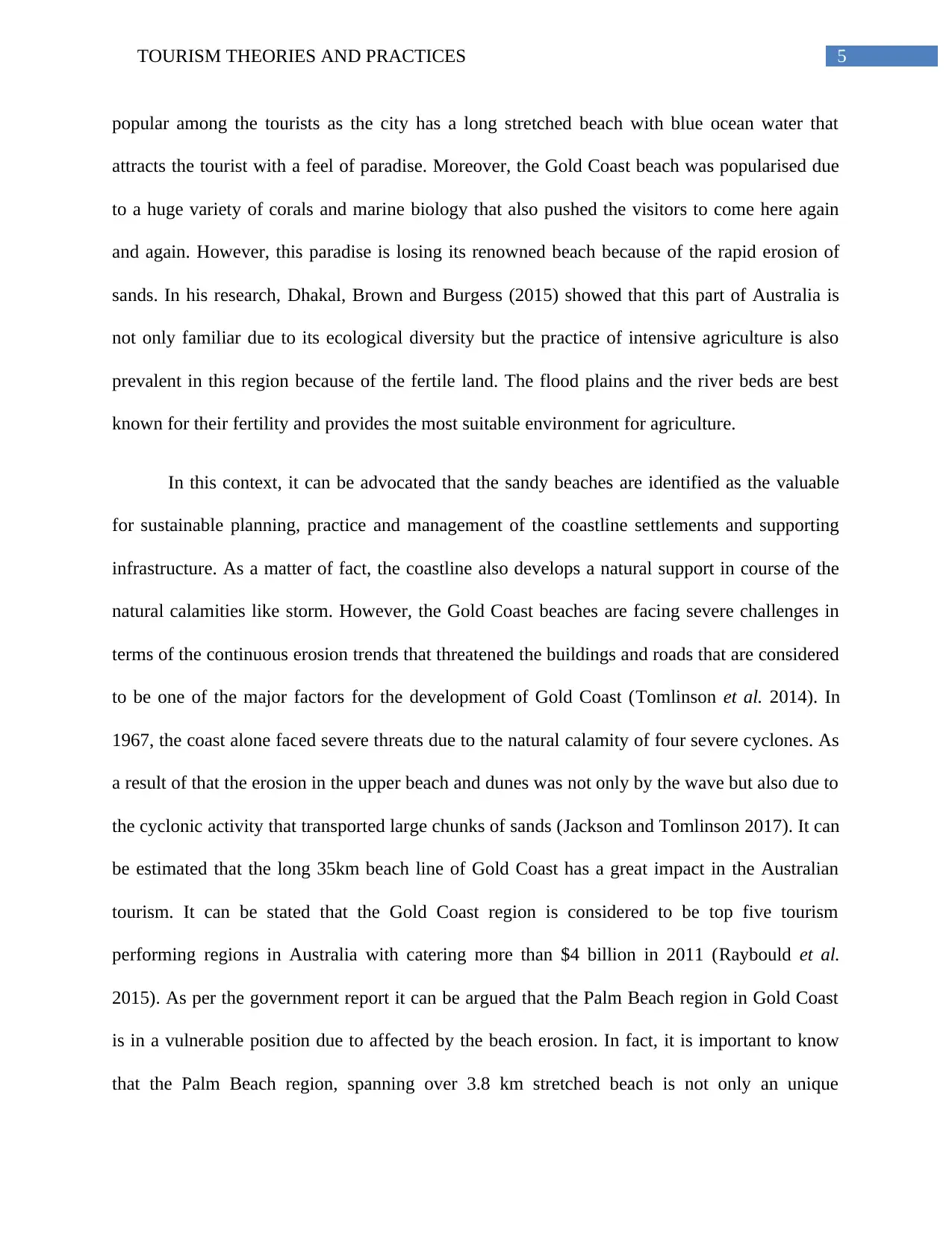
5TOURISM THEORIES AND PRACTICES
popular among the tourists as the city has a long stretched beach with blue ocean water that
attracts the tourist with a feel of paradise. Moreover, the Gold Coast beach was popularised due
to a huge variety of corals and marine biology that also pushed the visitors to come here again
and again. However, this paradise is losing its renowned beach because of the rapid erosion of
sands. In his research, Dhakal, Brown and Burgess (2015) showed that this part of Australia is
not only familiar due to its ecological diversity but the practice of intensive agriculture is also
prevalent in this region because of the fertile land. The flood plains and the river beds are best
known for their fertility and provides the most suitable environment for agriculture.
In this context, it can be advocated that the sandy beaches are identified as the valuable
for sustainable planning, practice and management of the coastline settlements and supporting
infrastructure. As a matter of fact, the coastline also develops a natural support in course of the
natural calamities like storm. However, the Gold Coast beaches are facing severe challenges in
terms of the continuous erosion trends that threatened the buildings and roads that are considered
to be one of the major factors for the development of Gold Coast (Tomlinson et al. 2014). In
1967, the coast alone faced severe threats due to the natural calamity of four severe cyclones. As
a result of that the erosion in the upper beach and dunes was not only by the wave but also due to
the cyclonic activity that transported large chunks of sands (Jackson and Tomlinson 2017). It can
be estimated that the long 35km beach line of Gold Coast has a great impact in the Australian
tourism. It can be stated that the Gold Coast region is considered to be top five tourism
performing regions in Australia with catering more than $4 billion in 2011 (Raybould et al.
2015). As per the government report it can be argued that the Palm Beach region in Gold Coast
is in a vulnerable position due to affected by the beach erosion. In fact, it is important to know
that the Palm Beach region, spanning over 3.8 km stretched beach is not only an unique
popular among the tourists as the city has a long stretched beach with blue ocean water that
attracts the tourist with a feel of paradise. Moreover, the Gold Coast beach was popularised due
to a huge variety of corals and marine biology that also pushed the visitors to come here again
and again. However, this paradise is losing its renowned beach because of the rapid erosion of
sands. In his research, Dhakal, Brown and Burgess (2015) showed that this part of Australia is
not only familiar due to its ecological diversity but the practice of intensive agriculture is also
prevalent in this region because of the fertile land. The flood plains and the river beds are best
known for their fertility and provides the most suitable environment for agriculture.
In this context, it can be advocated that the sandy beaches are identified as the valuable
for sustainable planning, practice and management of the coastline settlements and supporting
infrastructure. As a matter of fact, the coastline also develops a natural support in course of the
natural calamities like storm. However, the Gold Coast beaches are facing severe challenges in
terms of the continuous erosion trends that threatened the buildings and roads that are considered
to be one of the major factors for the development of Gold Coast (Tomlinson et al. 2014). In
1967, the coast alone faced severe threats due to the natural calamity of four severe cyclones. As
a result of that the erosion in the upper beach and dunes was not only by the wave but also due to
the cyclonic activity that transported large chunks of sands (Jackson and Tomlinson 2017). It can
be estimated that the long 35km beach line of Gold Coast has a great impact in the Australian
tourism. It can be stated that the Gold Coast region is considered to be top five tourism
performing regions in Australia with catering more than $4 billion in 2011 (Raybould et al.
2015). As per the government report it can be argued that the Palm Beach region in Gold Coast
is in a vulnerable position due to affected by the beach erosion. In fact, it is important to know
that the Palm Beach region, spanning over 3.8 km stretched beach is not only an unique
⊘ This is a preview!⊘
Do you want full access?
Subscribe today to unlock all pages.

Trusted by 1+ million students worldwide

6TOURISM THEORIES AND PRACTICES
destination place because of its ecological diversity but also has archaeological significance as
the region is the old settlements of the Australian aboriginals dated back to 20,000 years (Ware
and Banhalmi-Zakar 2017). Gradually in course of time with the British settlements and the later
on developed as a better tourist hotspot it became a better place for the tourists to come and
enjoyed some valuable time.
2.1 Different factors behind the issue
There are number of issues that created heavy problems for the Gold Coast beach to
sustain in the near future. The climatic disturbances in one of the factors that damages and erodes
the beach massively. However one of the major factor can be pointed out as the over-tourism
trends in this region. As this place is considered to be one of the popular tourist hotspots
therefore every year people all over the world come and spend some enjoyable time in this
region. As a result of that this place became an urban city with change in time and now
considered to be labelled as a city. In this context, Helman and Tomlinson (2018) rightly pointed
out that the urban beaches are primarily used for leisure services. People are playing and joining
sports in the urban beaches as the tourist organisations utilise those beaches as a tool to attract
more and more customers. Inevitably with the gathering and coming of such a great number of
people those beaches became a source of huge profits for the governments (Eijkelkamp et al.
2017). In fact, the government agencies are forced and encourage the local and international
tourist companies to invest more in those beaches in order to maximise more profit for the
government. Therefore, the government organisations also put more interests to weigh the social
and economic benefits provided by the beaches.
In case of Australia, 85% of the population live across the 50km of the coast and the
beaches are played a significant role in their life (Foteinis and Synolakis 2015). As a matter of
destination place because of its ecological diversity but also has archaeological significance as
the region is the old settlements of the Australian aboriginals dated back to 20,000 years (Ware
and Banhalmi-Zakar 2017). Gradually in course of time with the British settlements and the later
on developed as a better tourist hotspot it became a better place for the tourists to come and
enjoyed some valuable time.
2.1 Different factors behind the issue
There are number of issues that created heavy problems for the Gold Coast beach to
sustain in the near future. The climatic disturbances in one of the factors that damages and erodes
the beach massively. However one of the major factor can be pointed out as the over-tourism
trends in this region. As this place is considered to be one of the popular tourist hotspots
therefore every year people all over the world come and spend some enjoyable time in this
region. As a result of that this place became an urban city with change in time and now
considered to be labelled as a city. In this context, Helman and Tomlinson (2018) rightly pointed
out that the urban beaches are primarily used for leisure services. People are playing and joining
sports in the urban beaches as the tourist organisations utilise those beaches as a tool to attract
more and more customers. Inevitably with the gathering and coming of such a great number of
people those beaches became a source of huge profits for the governments (Eijkelkamp et al.
2017). In fact, the government agencies are forced and encourage the local and international
tourist companies to invest more in those beaches in order to maximise more profit for the
government. Therefore, the government organisations also put more interests to weigh the social
and economic benefits provided by the beaches.
In case of Australia, 85% of the population live across the 50km of the coast and the
beaches are played a significant role in their life (Foteinis and Synolakis 2015). As a matter of
Paraphrase This Document
Need a fresh take? Get an instant paraphrase of this document with our AI Paraphraser
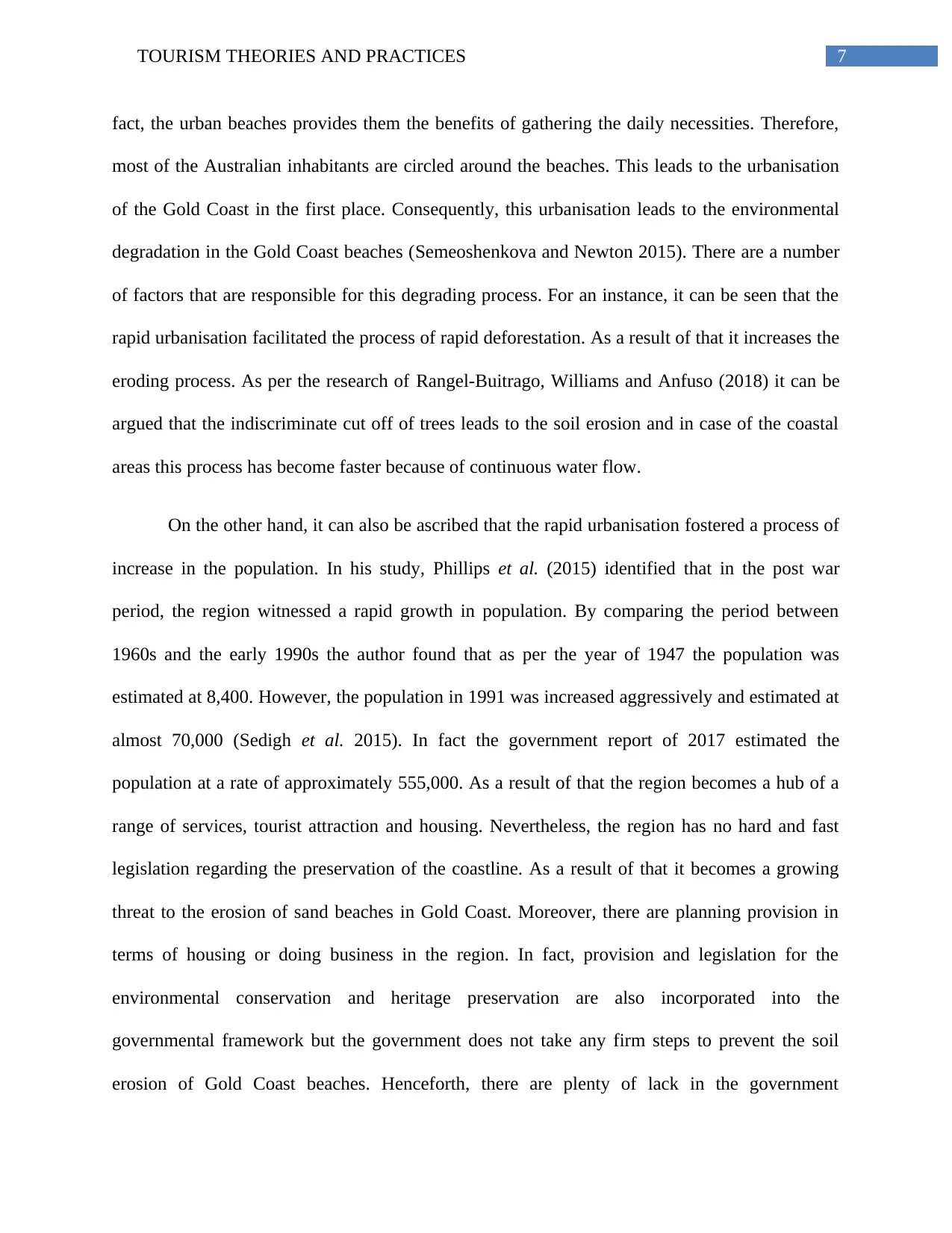
7TOURISM THEORIES AND PRACTICES
fact, the urban beaches provides them the benefits of gathering the daily necessities. Therefore,
most of the Australian inhabitants are circled around the beaches. This leads to the urbanisation
of the Gold Coast in the first place. Consequently, this urbanisation leads to the environmental
degradation in the Gold Coast beaches (Semeoshenkova and Newton 2015). There are a number
of factors that are responsible for this degrading process. For an instance, it can be seen that the
rapid urbanisation facilitated the process of rapid deforestation. As a result of that it increases the
eroding process. As per the research of Rangel-Buitrago, Williams and Anfuso (2018) it can be
argued that the indiscriminate cut off of trees leads to the soil erosion and in case of the coastal
areas this process has become faster because of continuous water flow.
On the other hand, it can also be ascribed that the rapid urbanisation fostered a process of
increase in the population. In his study, Phillips et al. (2015) identified that in the post war
period, the region witnessed a rapid growth in population. By comparing the period between
1960s and the early 1990s the author found that as per the year of 1947 the population was
estimated at 8,400. However, the population in 1991 was increased aggressively and estimated at
almost 70,000 (Sedigh et al. 2015). In fact the government report of 2017 estimated the
population at a rate of approximately 555,000. As a result of that the region becomes a hub of a
range of services, tourist attraction and housing. Nevertheless, the region has no hard and fast
legislation regarding the preservation of the coastline. As a result of that it becomes a growing
threat to the erosion of sand beaches in Gold Coast. Moreover, there are planning provision in
terms of housing or doing business in the region. In fact, provision and legislation for the
environmental conservation and heritage preservation are also incorporated into the
governmental framework but the government does not take any firm steps to prevent the soil
erosion of Gold Coast beaches. Henceforth, there are plenty of lack in the government
fact, the urban beaches provides them the benefits of gathering the daily necessities. Therefore,
most of the Australian inhabitants are circled around the beaches. This leads to the urbanisation
of the Gold Coast in the first place. Consequently, this urbanisation leads to the environmental
degradation in the Gold Coast beaches (Semeoshenkova and Newton 2015). There are a number
of factors that are responsible for this degrading process. For an instance, it can be seen that the
rapid urbanisation facilitated the process of rapid deforestation. As a result of that it increases the
eroding process. As per the research of Rangel-Buitrago, Williams and Anfuso (2018) it can be
argued that the indiscriminate cut off of trees leads to the soil erosion and in case of the coastal
areas this process has become faster because of continuous water flow.
On the other hand, it can also be ascribed that the rapid urbanisation fostered a process of
increase in the population. In his study, Phillips et al. (2015) identified that in the post war
period, the region witnessed a rapid growth in population. By comparing the period between
1960s and the early 1990s the author found that as per the year of 1947 the population was
estimated at 8,400. However, the population in 1991 was increased aggressively and estimated at
almost 70,000 (Sedigh et al. 2015). In fact the government report of 2017 estimated the
population at a rate of approximately 555,000. As a result of that the region becomes a hub of a
range of services, tourist attraction and housing. Nevertheless, the region has no hard and fast
legislation regarding the preservation of the coastline. As a result of that it becomes a growing
threat to the erosion of sand beaches in Gold Coast. Moreover, there are planning provision in
terms of housing or doing business in the region. In fact, provision and legislation for the
environmental conservation and heritage preservation are also incorporated into the
governmental framework but the government does not take any firm steps to prevent the soil
erosion of Gold Coast beaches. Henceforth, there are plenty of lack in the government
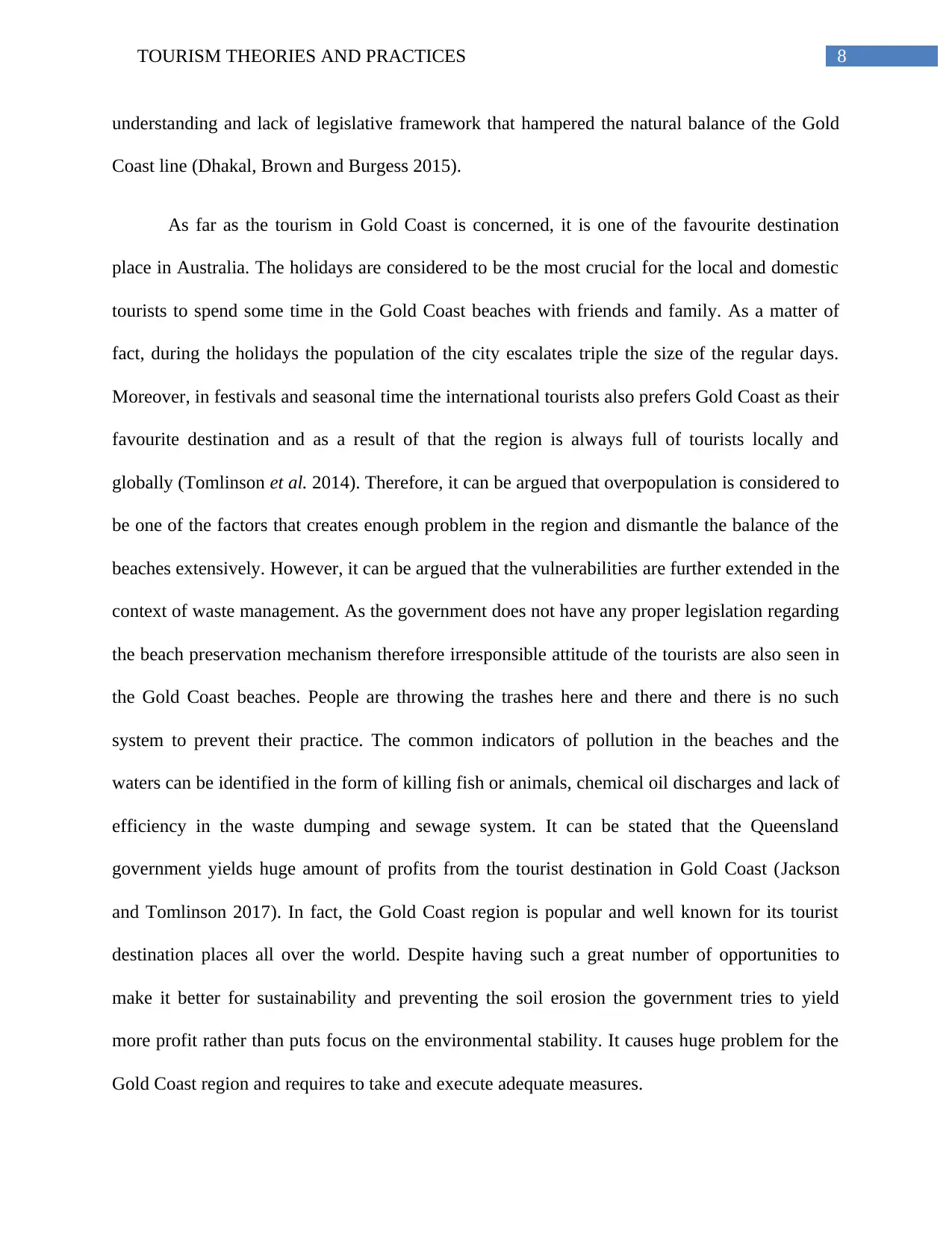
8TOURISM THEORIES AND PRACTICES
understanding and lack of legislative framework that hampered the natural balance of the Gold
Coast line (Dhakal, Brown and Burgess 2015).
As far as the tourism in Gold Coast is concerned, it is one of the favourite destination
place in Australia. The holidays are considered to be the most crucial for the local and domestic
tourists to spend some time in the Gold Coast beaches with friends and family. As a matter of
fact, during the holidays the population of the city escalates triple the size of the regular days.
Moreover, in festivals and seasonal time the international tourists also prefers Gold Coast as their
favourite destination and as a result of that the region is always full of tourists locally and
globally (Tomlinson et al. 2014). Therefore, it can be argued that overpopulation is considered to
be one of the factors that creates enough problem in the region and dismantle the balance of the
beaches extensively. However, it can be argued that the vulnerabilities are further extended in the
context of waste management. As the government does not have any proper legislation regarding
the beach preservation mechanism therefore irresponsible attitude of the tourists are also seen in
the Gold Coast beaches. People are throwing the trashes here and there and there is no such
system to prevent their practice. The common indicators of pollution in the beaches and the
waters can be identified in the form of killing fish or animals, chemical oil discharges and lack of
efficiency in the waste dumping and sewage system. It can be stated that the Queensland
government yields huge amount of profits from the tourist destination in Gold Coast (Jackson
and Tomlinson 2017). In fact, the Gold Coast region is popular and well known for its tourist
destination places all over the world. Despite having such a great number of opportunities to
make it better for sustainability and preventing the soil erosion the government tries to yield
more profit rather than puts focus on the environmental stability. It causes huge problem for the
Gold Coast region and requires to take and execute adequate measures.
understanding and lack of legislative framework that hampered the natural balance of the Gold
Coast line (Dhakal, Brown and Burgess 2015).
As far as the tourism in Gold Coast is concerned, it is one of the favourite destination
place in Australia. The holidays are considered to be the most crucial for the local and domestic
tourists to spend some time in the Gold Coast beaches with friends and family. As a matter of
fact, during the holidays the population of the city escalates triple the size of the regular days.
Moreover, in festivals and seasonal time the international tourists also prefers Gold Coast as their
favourite destination and as a result of that the region is always full of tourists locally and
globally (Tomlinson et al. 2014). Therefore, it can be argued that overpopulation is considered to
be one of the factors that creates enough problem in the region and dismantle the balance of the
beaches extensively. However, it can be argued that the vulnerabilities are further extended in the
context of waste management. As the government does not have any proper legislation regarding
the beach preservation mechanism therefore irresponsible attitude of the tourists are also seen in
the Gold Coast beaches. People are throwing the trashes here and there and there is no such
system to prevent their practice. The common indicators of pollution in the beaches and the
waters can be identified in the form of killing fish or animals, chemical oil discharges and lack of
efficiency in the waste dumping and sewage system. It can be stated that the Queensland
government yields huge amount of profits from the tourist destination in Gold Coast (Jackson
and Tomlinson 2017). In fact, the Gold Coast region is popular and well known for its tourist
destination places all over the world. Despite having such a great number of opportunities to
make it better for sustainability and preventing the soil erosion the government tries to yield
more profit rather than puts focus on the environmental stability. It causes huge problem for the
Gold Coast region and requires to take and execute adequate measures.
⊘ This is a preview!⊘
Do you want full access?
Subscribe today to unlock all pages.

Trusted by 1+ million students worldwide

9TOURISM THEORIES AND PRACTICES
3. Recommended tourism plan
Goals Activities Time frame Rationale
Creation of
policies to restrict
excessive tourism
Analysis of the
situation and
identification of
the issues that are
faced by the Gold
coast will be
helping the
government and
the environmental
protection
agencies in
maintaining the
efficacy of the
sustainable
practices in
tourism activities.
Implementation
of The Coastal
Protection and
Management Act
of 1995 delineates
3- 4 years The
Implementation of
the policies will be
helping the
environmental
protection and
government
agencies in
regulating the
tourism activities
that might cause
harm to the Gold
Coast (Miller,
Merrilees and
Coghlan 2015).
3. Recommended tourism plan
Goals Activities Time frame Rationale
Creation of
policies to restrict
excessive tourism
Analysis of the
situation and
identification of
the issues that are
faced by the Gold
coast will be
helping the
government and
the environmental
protection
agencies in
maintaining the
efficacy of the
sustainable
practices in
tourism activities.
Implementation
of The Coastal
Protection and
Management Act
of 1995 delineates
3- 4 years The
Implementation of
the policies will be
helping the
environmental
protection and
government
agencies in
regulating the
tourism activities
that might cause
harm to the Gold
Coast (Miller,
Merrilees and
Coghlan 2015).
Paraphrase This Document
Need a fresh take? Get an instant paraphrase of this document with our AI Paraphraser
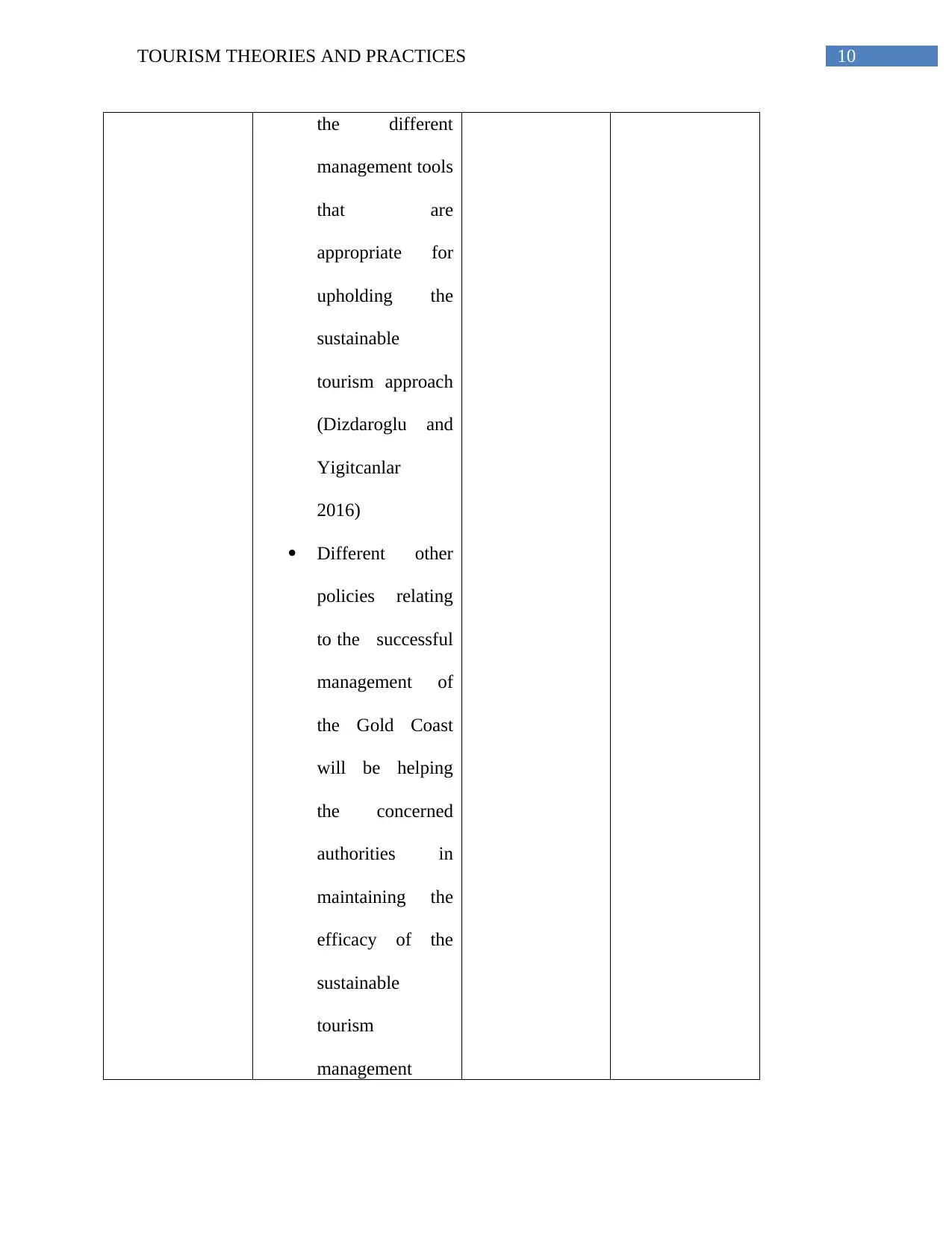
10TOURISM THEORIES AND PRACTICES
the different
management tools
that are
appropriate for
upholding the
sustainable
tourism approach
(Dizdaroglu and
Yigitcanlar
2016)
Different other
policies relating
to the successful
management of
the Gold Coast
will be helping
the concerned
authorities in
maintaining the
efficacy of the
sustainable
tourism
management
the different
management tools
that are
appropriate for
upholding the
sustainable
tourism approach
(Dizdaroglu and
Yigitcanlar
2016)
Different other
policies relating
to the successful
management of
the Gold Coast
will be helping
the concerned
authorities in
maintaining the
efficacy of the
sustainable
tourism
management
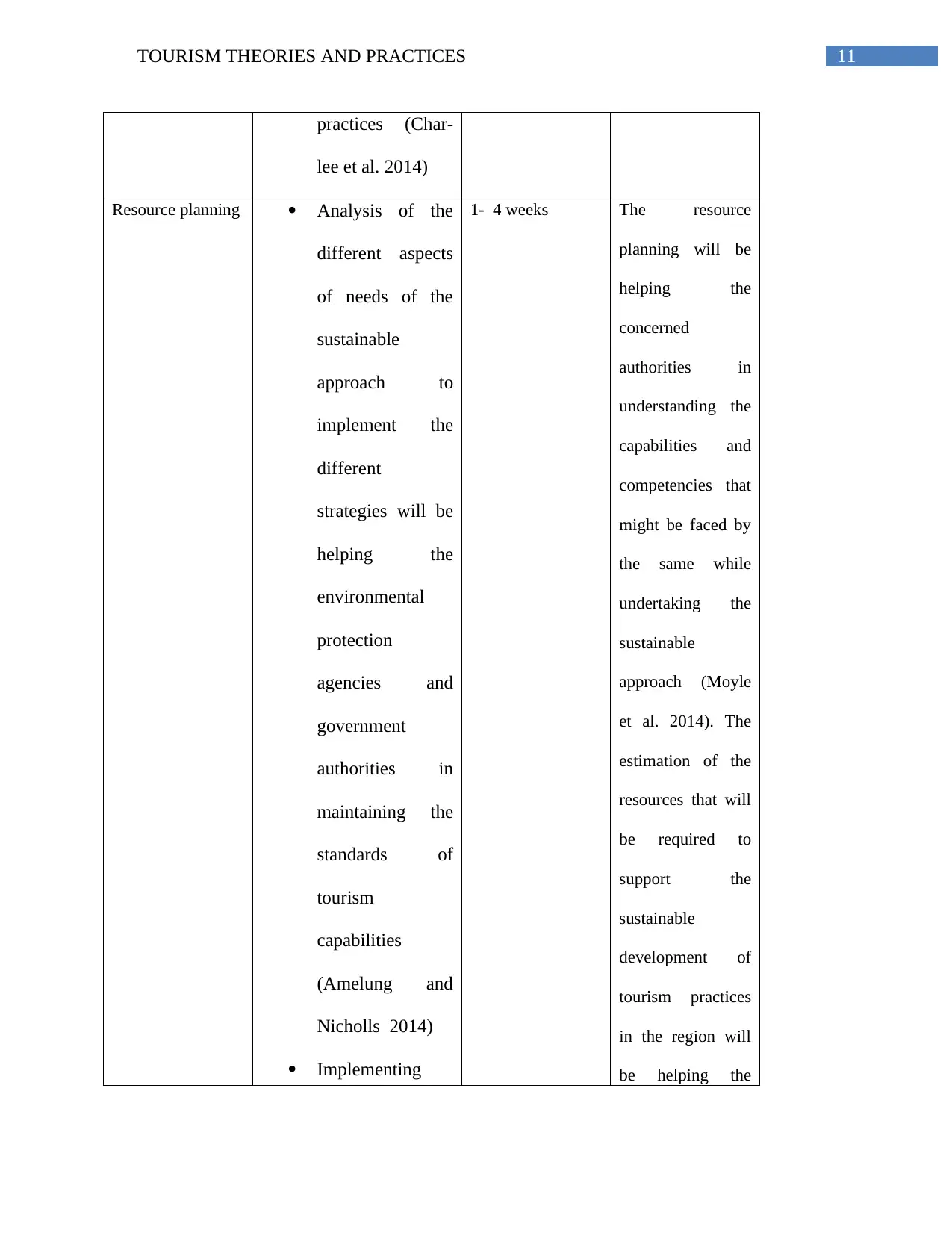
11TOURISM THEORIES AND PRACTICES
practices (Char-
lee et al. 2014)
Resource planning Analysis of the
different aspects
of needs of the
sustainable
approach to
implement the
different
strategies will be
helping the
environmental
protection
agencies and
government
authorities in
maintaining the
standards of
tourism
capabilities
(Amelung and
Nicholls 2014)
Implementing
1- 4 weeks The resource
planning will be
helping the
concerned
authorities in
understanding the
capabilities and
competencies that
might be faced by
the same while
undertaking the
sustainable
approach (Moyle
et al. 2014). The
estimation of the
resources that will
be required to
support the
sustainable
development of
tourism practices
in the region will
be helping the
practices (Char-
lee et al. 2014)
Resource planning Analysis of the
different aspects
of needs of the
sustainable
approach to
implement the
different
strategies will be
helping the
environmental
protection
agencies and
government
authorities in
maintaining the
standards of
tourism
capabilities
(Amelung and
Nicholls 2014)
Implementing
1- 4 weeks The resource
planning will be
helping the
concerned
authorities in
understanding the
capabilities and
competencies that
might be faced by
the same while
undertaking the
sustainable
approach (Moyle
et al. 2014). The
estimation of the
resources that will
be required to
support the
sustainable
development of
tourism practices
in the region will
be helping the
⊘ This is a preview!⊘
Do you want full access?
Subscribe today to unlock all pages.

Trusted by 1+ million students worldwide
1 out of 23
Related Documents
Your All-in-One AI-Powered Toolkit for Academic Success.
+13062052269
info@desklib.com
Available 24*7 on WhatsApp / Email
![[object Object]](/_next/static/media/star-bottom.7253800d.svg)
Unlock your academic potential
Copyright © 2020–2025 A2Z Services. All Rights Reserved. Developed and managed by ZUCOL.




